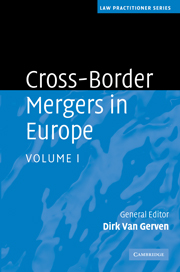Book contents
- Frontmatter
- Contents
- Contributors
- Preface
- Part I EC rules on cross-border mergers
- 1 Community rules applicable to cross-border mergers
- 2 Employee participation: rights and obligations
- 3 Tax rules applicable to cross-border mergers
- 4 Scope and limitations of the Cross-border Merger Directive
- Part II Application in each Member State National reports for the EU Member States
- Part III Application in the EEA Member States
- Part IV Annexes
- Index
1 - Community rules applicable to cross-border mergers
from Part I - EC rules on cross-border mergers
Published online by Cambridge University Press: 03 May 2010
- Frontmatter
- Contents
- Contributors
- Preface
- Part I EC rules on cross-border mergers
- 1 Community rules applicable to cross-border mergers
- 2 Employee participation: rights and obligations
- 3 Tax rules applicable to cross-border mergers
- 4 Scope and limitations of the Cross-border Merger Directive
- Part II Application in each Member State National reports for the EU Member States
- Part III Application in the EEA Member States
- Part IV Annexes
- Index
Summary
Introduction
Purpose
1. Mergers between companies situated in different Member States are difficult. In certain jurisdictions, it is unclear whether a cross-border merger is even possible, especially if the company created through the merger will have its registered or head office in another state.
Directive 2005/56/EC of the European Parliament and of the Council of 26 October 2005 on cross-border mergers of limited liability companies (the ‘Cross-border Merger Directive’ or the ‘Dir.’) is intended to facilitate this type of merger by providing procedural rules. A copy of the Directive can be found in Annex I of this book.
The Cross-border Merger Directive does not affect the applicable provisions of national law. Thus, each company taking part in a cross-border merger remains subject to the provisions and formalities of national law which would apply in the case of a purely domestic merger. However, these national rules should be largely harmonised thanks to transposition of the Third Council Directive (78/855/EEC) of 9 October 1978 concerning mergers of public limited liability companies (the ‘Domestic Merger Directive’).
History
2. The Cross-border Merger Directive is based on a proposal by the European Commission of 18 November 2003 for a directive on cross-border mergers of companies with share capital. In its Explanatory Memorandum, the Commission explains that European companies have been requesting for some time a legal instrument which will enable them to carry out cross-border mergers.
- Type
- Chapter
- Information
- Cross-Border Mergers in Europe , pp. 3 - 28Publisher: Cambridge University PressPrint publication year: 2010
- 2
- Cited by



